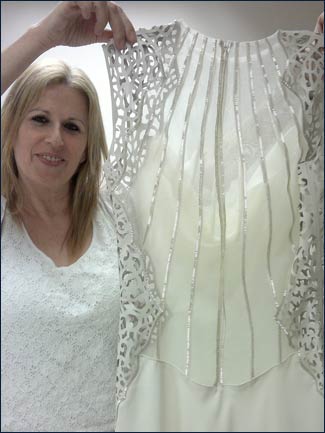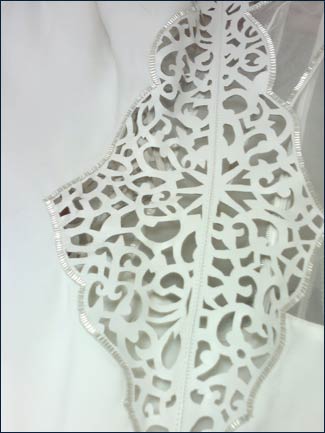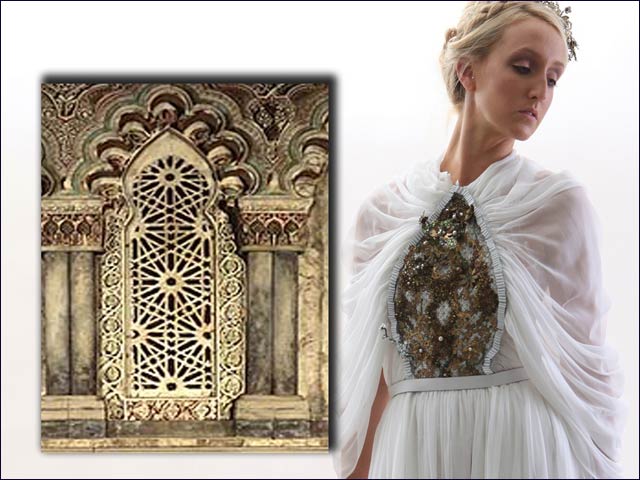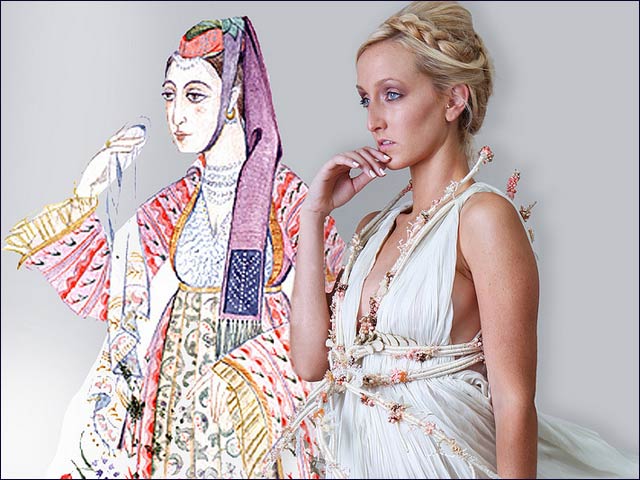By Avigayil Kadesh
Irit Admoni Perlman gingerly holds a priceless, handcrafted wedding gown aloft, pointing out the tiny, painstakingly set silver slivers that run in two lines down its bodice to evoke the frets of a musical instrument. The front and back of the dress are joined by hand-cut leather insets that mirror the decorative elements of the oud and the qanun, two traditional Middle Eastern stringed instruments.
 Irit Admoni Perlman with Adi Bakshi’s gown inspired by the oud
Irit Admoni Perlman with Adi Bakshi’s gown inspired by the oudThis gown by Adi Baskhi is one of 14 unique wedding garments featured in “Here Comes the Bride: Wedding Gowns Embroidering the Story of the Jewish People,” on exhibit at Tel Aviv’s
Beit Hatfutsot, The Museum of the Jewish People, from September 18, 2013 through February 28, 2014. The show will then travel to Vienna and other international cities.
“There is nothing like this in the world,” asserts Perlman, director of Israel Friends of Beit Hatfutsot.
When she took the position almost four years ago, Perlman was eager to introduce a collaborative exhibit with another Israeli institution. At the suggestion of board member Motty Reif, she approached Leah Peretz, head of the
fashion design department at Shenkar College of Engineering and Design, and Ronen Levin, instructor of Shenkar’s course on bridal gown design.
They suggested a project by the 14 third-year students in Levin’s course, inspired by objects at Beit Hatfutstot. Levin co-curated the show along with Neta Harel and chief curator Orit Shaham Gover.
This unique exhibition shows how the museum’s collections -- which portray the global cultural variations within the Jewish heritage -- can serve as an inspiration for fashion design students.
“We thought the models of synagogues would be perfect for connecting them with the various traditions, since lifecycle ceremonies are associated with the synagogue,” says Perlman. They also had access to the entire archives -- Judaica, ketubot (marriage contracts), musical instruments, embroidery, dowry chests and family photos.
Perlman notes that the museum's theme, "You are Part of the Story," became the guiding principle for the students’ research as well. “Most of them started with one idea and ended up with something else. At the end of the day, they all did something related to their roots.”
The styles and traditions of Jewish communities of countries including Yemen, Iraq, Turkey, Greece, Spain, Poland, Germany, Morocco and Algeria are recreated in the 13 bridal dresses, one henna ceremonial gown and one groom’s outfit on display.
In their own words
Each student was given a sketchbook, all of which are included in the final exhibit. The books show drawings and paintings, images and stories, patterns, fabrics and embroidery samples. Each student also used the book to explain the development of his or her conceptual design.
“My father's home, and the music that was the soundtrack of the celebrations and weddings of the community of Iraqi Jews among whom we had lived, served as the source of my inspiration,” writes Bakshi of her crepe-and-organza creation.
“While designing the dress, I focused on building the musical instruments such as the delicate oriental-style woodcuts with thin silver cords. I found similar decorative elements in the amulets and hamsa talismans that were commonly used in Baghdad as protection from the evil eye.”
 Detail of the hand-cut leather on Bakshi’s design
Detail of the hand-cut leather on Bakshi’s design Delicate crochet embroidery incorporated into Hadar Brin’s voile gown expresses the meticulous scribal arts practiced by her great-grandfather in Poland. She explains that several years ago, after her grandfather died, the family tracked down and reclaimed a mezuzah made by her ancestor and hidden at the outbreak of the Second World War.
Levi Shenhav drew the inspiration for his design from a replica of a wall of the El Transito Synagogue in Toledo, Spain, which is displayed at Beit Hatfutsot. The original wall was a symbol of cooperation between the three monotheistic religions, integrating elements from Islamic decorative art, Christian painting styles and Jewish traditional art and calligraphy.
“I tailored my gown from white chiffon and incorporated beaten copper elements of leaf and flower motifs adorned with leather strips and light pearls, all inspired by the synagogue’s structure,” he writes.
 Chiffon wedding gown by Levi Shenhav, inspired by a Spanish synagogue
Chiffon wedding gown by Levi Shenhav, inspired by a Spanish synagogue Chen Ariel Nachman learned that the women of Thessaloníki, Greece, from where his family hails, adorned their heads with ornamental amulets embroidered with baroque pearls for luck and blessings, arranged in the shape of the Tree of Life symbolizing the Torah and the cycle of life. So he tailored his gown from wrinkled chiffon embroidered with baroque pearls, lace and beads, sequin leather and ropes coiled with embroidery threads, reminiscent of the fringes on Jewish prayer shawls.

Chen Ariel Nachman’s “Tree of Life” design “I got the inspiration for my bridal gown from the house-like design of traditional 12th Century wedding rings that were popular in the communities of Speyer, Worms and Magenza (Mainz) in the German Rhine region,” writes Eyal Ron Meistal. “Wedding rings designed in the shape of a house symbolize the significance of the wedding day -- the establishment of a new Jewish home.”
His gown of wild silk is embroidered with thread and beads using ornamentation borrowed from the ring. Silk organza strengthened with Plexiglas rods symbolizes the wedding canopy rods that adorn the bride's veil.
All of the descriptions will be available in English as well as Hebrew, displayed alongside images or actual museum objects that served as the designers’ inspiration.
Perlman explains that the Shenkar collection was debuted at the 2012 Fashion Week and was also featured at the 2012 Nadav Foundation Awards event. The foundation is a Beit Hatfutsot supporter and one of the sponsors of the “Here Come the Brides” exhibit. With the help of the Foreign Ministry, the show is expected to travel to additional cities, such as Shanghai.